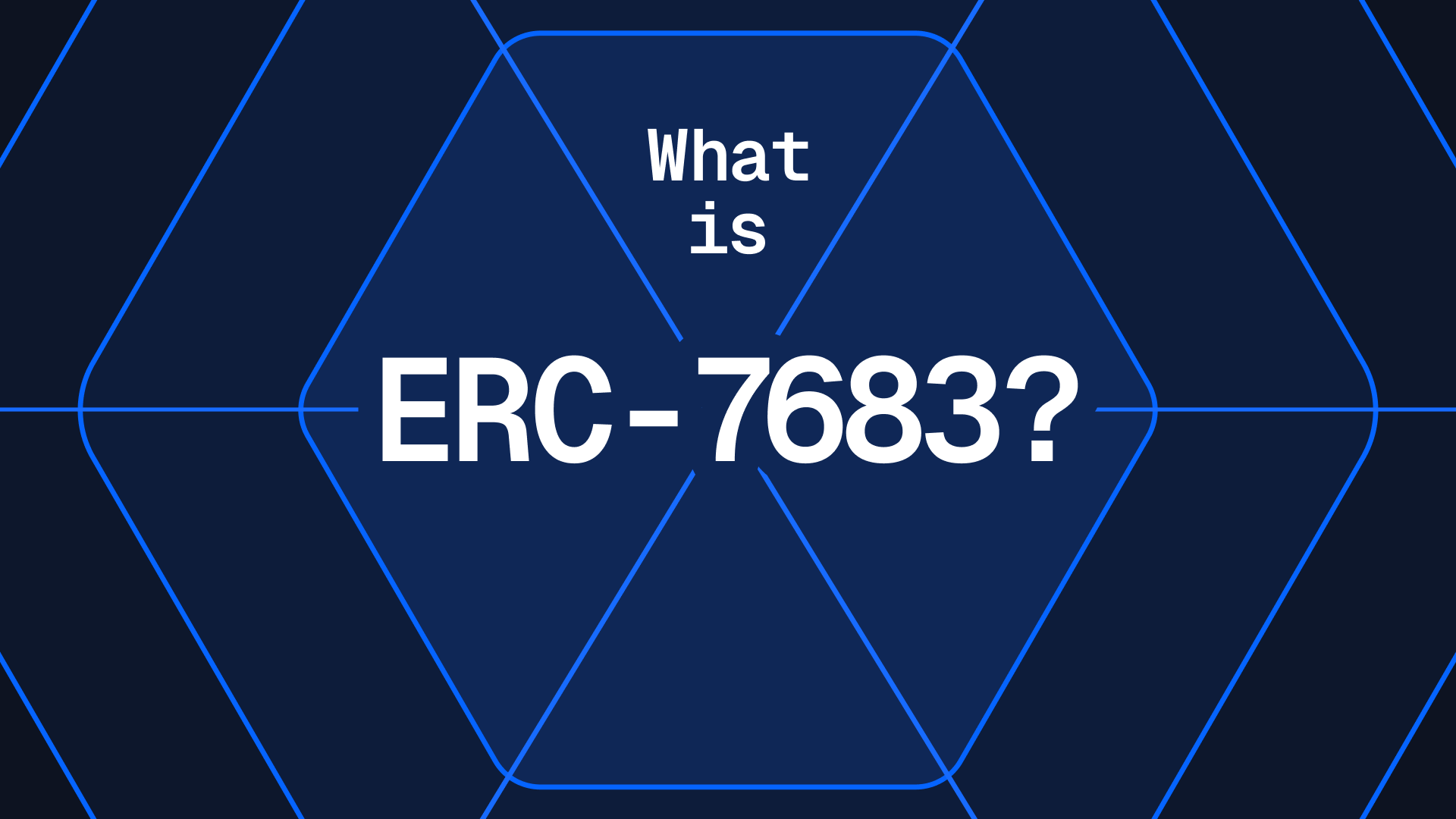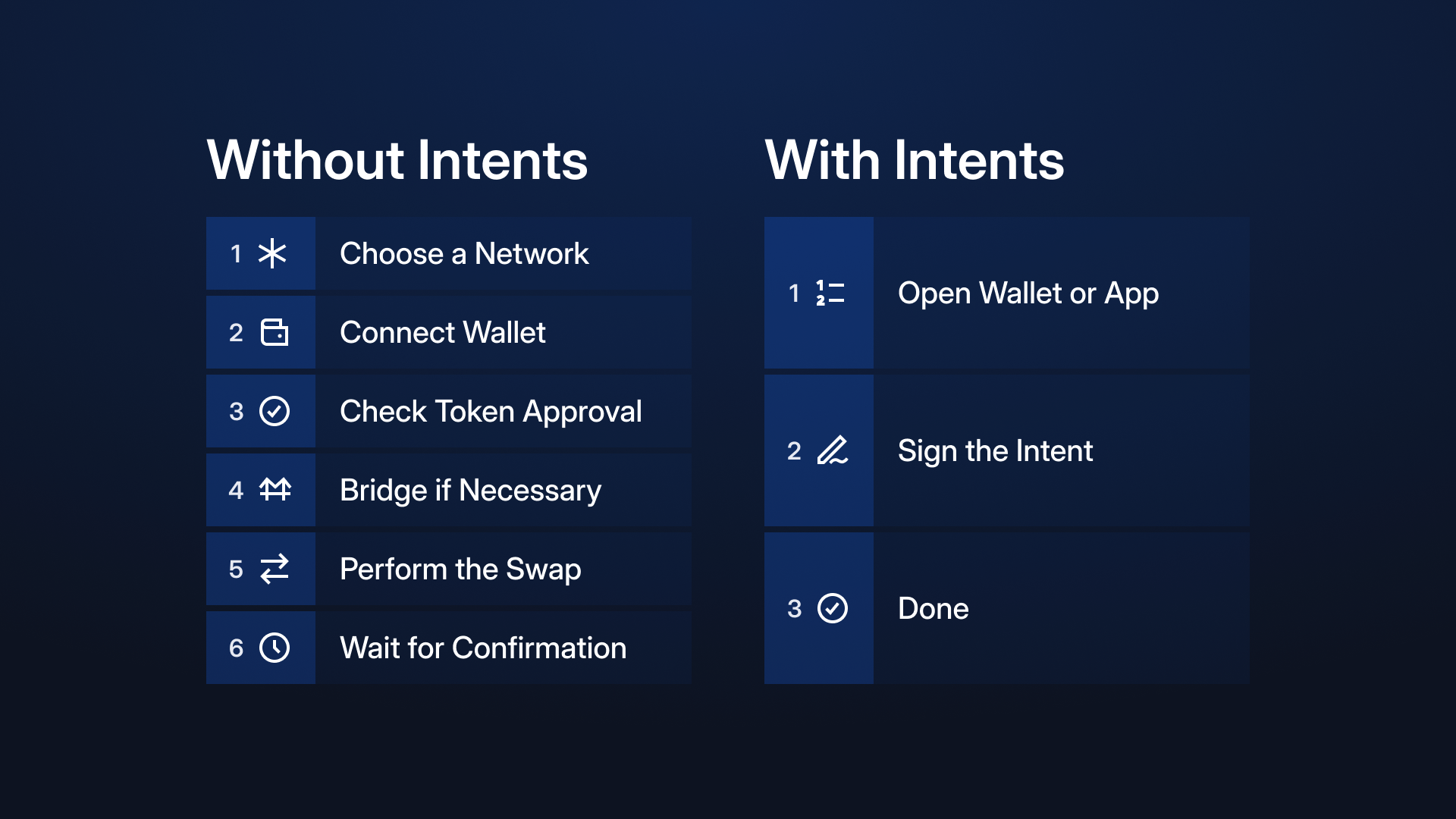How ERC-7683 Will Catalyze the Intents Landscape and Drive Adoption

Introduction
ERC-7683 is a new Ethereum standard for cross-chain intents, with Omni Network as a key contributor. Its goal is to simplify complex user actions, especially those involving cross-chain transactions. With intents, users no longer need to manually bridge assets, switch networks and manage multiple transactions, instead they simply declare their desired outcomes, while letting the underlying solvers handle execution.
Understanding Intents
What are Intents?

An intent is a high-level expression of a user’s desired outcome, abstracting away the low-level transaction steps. For example, rather than executing a series of transfers and swaps, a user might simply signal “I want to trade X amount of token A for at least Y amount of token B”.
Here, the user would sign a message with this desired outcome. From there, specialized actors called solvers, or fillers/relayers, then compete to fulfill that intent on behalf of the user. This flips the traditional transaction model to have users specify the “what,” not the “how,” and leave it to solvers to figure out the optimal execution.
How ERC-7683 Contributes to the Intents Landscape
Background and Purpose
ERC-7683 is a proposed Ethereum standard (an ERC, or Ethereum Request for Comment) introduced in 2024 through a collaboration between Uniswap Labs and Across Protocol. Its fundamental goal is to establish a unified framework for cross-chain intents creating a standard way for users to express what they want to do across chains, and for different solvers to understand and fulfill those requests.
The push for ERC-7683 comes with the growing fragmentation of liquidity and a poorer user experience in a multi-chain world. There are now over 100 Ethereum L2s and many more L1s each with their own bridges, liquidity pools, and protocols further complicating things. Intent-based solutions emerged as the preferred approach to fix this by abstracting away the bridges and delays, but until ERC-7683, each project was building its own bespoke intent format and solver network.
Why is ERC-7683 Needed?
ERC-7683 is needed to unify the efforts of all teams building in the intents sector. If all intent-based protocols speak the same “language,” they can share infrastructure and interoperate leading to a much better experience for users.
In other words, ERC-7683 is like establishing a standard “API” for cross-chain operations driven by user intents. This common standard means an intent created in one dApp or wallet could be filled by any compliant solver network, not just the app’s proprietary relayer opening the door to a universal marketplace of intents.
Technical Overview: Key Components of ERC-7683
CrossChainOrder Structure
At the core of ERC-7683 is the CrossChainOrder, a structured message describing exactly what a user wants to achieve across chains, including the origin and destination chains, assets involved, user address, and critical deadlines. Two variants exist: the GaslessCrossChainOrder for off-chain signatures submitted by solvers, and the simpler OnchainCrossChainOrder for user-submitted transactions directly onchain. Every order can also be deterministically converted into a ResolvedCrossChainOrder, ensuring clarity and consistency across diverse implementations.
ISettlementContract Interface
ERC-7683 defines settlement contracts through two standardized interfaces: IOriginSettler and IDestinationSettler. In essence, the origin chain announces user intents, and the destination chain empowers solvers to competitively fulfill them.
Fulfill Mechanism
ERC-7683's fulfill mechanism transforms intent fulfillment into an open competition among solvers. Rather than restricting who can fulfill an intent, ERC-7683 broadcasts intents openly, allowing solvers to compete to provide the best execution. Critical to this is the intent’s fillDeadline, ensuring user safety by setting a firm expiration, after which users can safely reclaim funds if no solver has filled the intent.
Fill Deadline
Every intent carries a time-to-live in the form of an openDeadLine and a fillDeadline. The fill deadline in particular is critical for user safety. It specifies the latest time by which the intent must be completed on the destination chain. If this time passes and no solver has fulfilled the intent, the order is considered expired. In practice, that means the user can safely reclaim their funds on the origin side knowing that no fill will occur after the deadline.
Order Data Type and Order Data
The Order data type in ERC-7683 refers to how the intent’s details are encoded and hashed. The standard leverages Ethereum’s EIP-712 to ensure that all parts of an intent like the who, what, where, and when, are covered by the user’s signature. By using an EIP-712 typed data hash, the intent signature is protected against replay on different chains or different contracts. For example, an intent might include the chain ID in the data, if someone tried to replay that signature on another chain the hash would be different and thus invalid.
Projects Driving ERC-7683 Adoption
Given ERC-7683's significance, several leading projects play a pivotal role in driving its adoption. Here we explore key contributors and adopters in detail:
Core Contributors & Drivers
Omni Network
Omni is a significant contributor to ERC-7683, primarily through its flagship product, Omni SolverNet. SolverNet allows developers to rapidly integrate intent-based interactions into existing frontends without altering smart contract logic. Omni actively shapes the ERC-7683 standard through direct engineering contributions, as demonstrated by recent proposals #772 and #773. Additionally, Omni engineers like Zodomo play crucial roles in community discussions on intent standardization.
Across Protocol
Across Protocol leverages ERC-7683, utilizing structured CrossChainOrder formats and standardized settlement contracts. This enables secure and instant cross-chain transactions, significantly improving the bridging experience by abstracting away complex steps. Across Protocol was among the initial co-authors of ERC-7683 alongside Uniswap Labs, underscoring its pivotal role in the standard's early adoption and refinement.
Uniswap X
Uniswap X integrates ERC-7683 into its trading mechanism, employing off-chain intent-based orders. Traders specify intents without interacting directly with AMM pools, and solvers competitively execute these trades using ERC-7683's fulfill mechanism. Uniswap Labs, the team behind Uniswap X, co-authored the ERC-7683 standard, demonstrating leadership and commitment to cross-chain intent-driven transactions.
Ethereum Foundation & Open Intents Framework
The Ethereum Foundation (EF), alongside Hyperlane and Bootnode, supports intent standardization through initiatives like the Open Intents Framework, which complements ERC-7683. The EF’s involvement highlights the foundational importance of intent-based standards for Ethereum's broader ecosystem strategy, facilitating interoperability and simplifying cross-chain user experiences.
Additional Supporters
Beyond these core drivers, numerous projects have publicly signaled support for ERC-7683, creating a growing ecosystem poised to adopt or integrate intent standards. For a comprehensive list of supporting projects, refer to the official ecosystem map on erc7683.org.
Potential Challenges
Design Limitations and Perspectives
As with most technical breakthroughs, ERC-7683 and intent-based systems have their own set of tradeoffs that are already being addressed. For example, projects are actively exploring adapters and translation layers that can convert intent formats and processes across fundamentally different smart contract platforms. Initiatives such as the Open Intents Framework aim to establish cross-VM standardization, potentially defining complementary standards in non-EVM ecosystems to enable seamless interoperability.
Additionally, intent architectures work best with fungible tokens and fungible operations. There’s a known challenge when it comes to NFTs or arbitrary data. The reason is that solvers typically front the liquidity on the destination chain, essentially providing a “loan” to the user for the funds or asset on the target chain before being reimbursed from the origin.
With fungible tokens, that’s fine, but with a one-of-a-kind NFT, a solver can’t exactly “front” a copy of that NFT on another chain without a trusted bridge minting a wrapped version. To address this, research into trust-minimized bridging solutions for NFTs is underway, leveraging wrapped NFTs, fractionalization, or escrow mechanisms to enable intent-based NFT transfers securely.
Implementation Concerns
Solver competition, while beneficial, introduces game-theoretic and technical complexities. Race conditions could arise if multiple solvers simultaneously attempt to fulfill the same intent, causing unnecessary gas expenditures. Solutions like solver coordination mechanisms, auction-based selection, or off-chain solver marketplaces are being explored to streamline solver interactions, minimize redundant efforts, and enhance efficiency.
Cross-chain intents inherently rely on underlying bridges or messaging layers, making their security dependent on these components. ERC-7683 doesn't directly solve bridge security concerns but does create a modular framework where robust and vetted bridge solutions, such as zk-based or optimistic bridge technologies, can be easily integrated.
Finally, to avoid fragmentation from numerous competing standards, the Ethereum community has begun converging around ERC-7683 for intents. Conversations continue around how ERC-7683 can effectively interoperate with other standards, like ERC-4337 (Account Abstraction).
Conclusion
ERC-7683 encapsulates the philosophy that users care about outcomes rather than blockchain complexities. By standardizing intents, ERC-7683 unlocks a new set of possibilities for cross-chain applications across DeFi, gaming, payments and so much more. Using the Open Intents Framework, developers can easily tap into an expanding ecosystem of solvers and unified user experiences to accelerate the growth and adoption of Web3.
